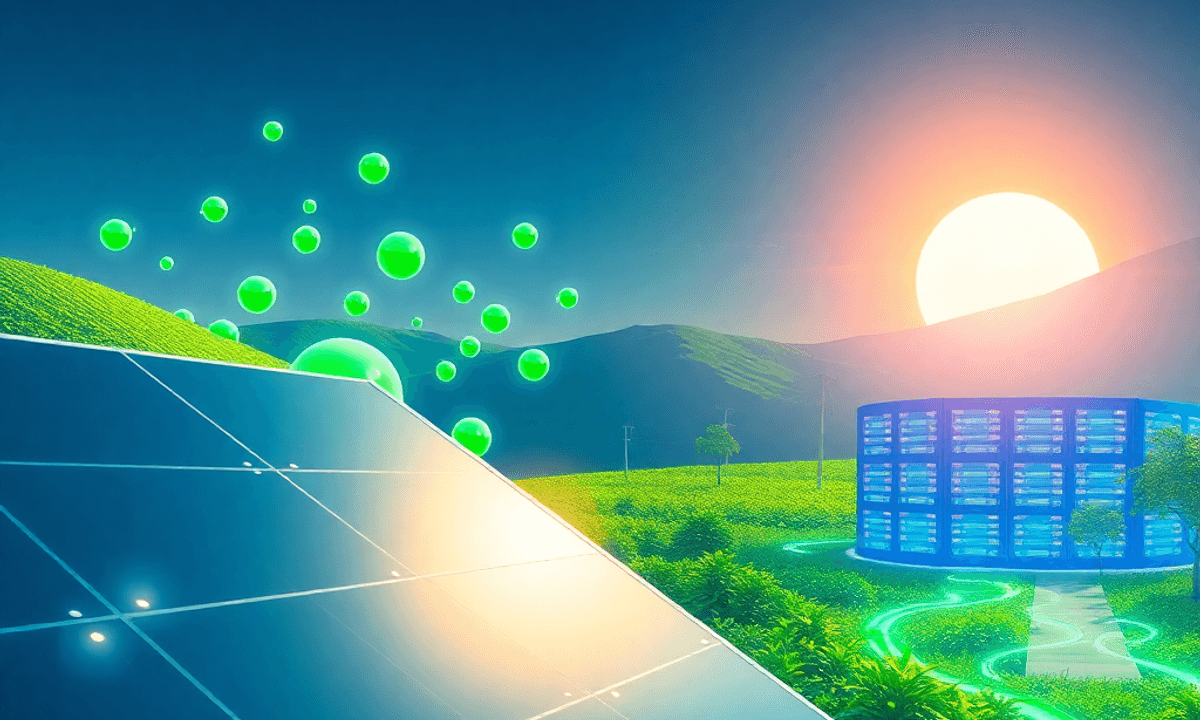Introduction
Stanislav Kondrashov has established himself as a leading voice in the realm of sustainable technologies, bringing decades of experience in analyzing and promoting green energy solutions and data center innovations. His work focuses on bridging the gap between cutting-edge technological advancement and practical environmental stewardship, making him a trusted authority in the field.
The urgency of climate action has never been more apparent. You’re witnessing a pivotal moment where innovation meets necessity, and the technologies we adopt today will shape the environment for generations to come. This exploration will take you through the transformative landscape of renewable energy, from breakthrough materials in solar panels to the revolutionary potential of green hydrogen. You’ll discover how energy storage solutions are evolving, how artificial intelligence is optimizing our power grids, and how seemingly disparate fields like agriculture and solar energy are converging in unexpected ways.
The journey toward sustainability isn’t just about reducing emissions—it’s about reimagining how we generate, store, and consume energy across every sector of our economy.
Current Trends in Renewable Energy Technologies
The renewable energy landscape is experiencing rapid transformation as breakthrough technologies push the boundaries of what’s possible in clean power generation. These innovations aren’t just incremental improvements—they represent fundamental shifts in how we capture, convert, and utilize energy from natural sources.
Perovskite Solar Panels: The Next Generation of Photovoltaics
Perovskite solar panels are changing the solar industry with their impressive efficiency gains. These panels achieve conversion rates exceeding 25%, rivaling traditional silicon-based technology while offering significant advantages. Perovskite cells are:
- Lighter and more flexible
- Manufactured at a fraction of the cost
- Able to absorb light across a broader spectrum
- Effective even in low-light conditions
- Produced using lower temperatures than silicon production, reducing carbon emissions
Floating Wind Turbines: Unlocking Deep-Water Potential
Floating wind turbines are expanding the possibilities for wind energy generation. Unlike traditional fixed-bottom turbines, these structures can be deployed in waters 60 meters deep or more by anchoring to the seabed with mooring systems. This allows access to stronger and more consistent winds found in deep offshore locations. Countries with limited shallow coastal waters can now harness their offshore wind resources, significantly increasing global wind energy capacity.
Green Hydrogen: The Carbon-Free Fuel Revolution
Green hydrogen production through renewable-powered electrolysis is gaining serious traction as an industrial energy solution. By using electricity from solar or wind sources to split water molecules, you can create hydrogen without any carbon emissions. This hydrogen can then be used as an energy carrier for sectors that are difficult to electrify directly, such as heavy industry, shipping, and aviation. The technology’s industrial viability continues improving as electrolyzer costs decline and renewable energy becomes cheaper.
Advancements in Energy Storage Solutions for a Sustainable Future
The renewable energy revolution faces a fundamental challenge: the sun doesn’t always shine, and the wind doesn’t always blow. Energy storage systems have emerged as the critical bridge between intermittent power generation and consistent electricity supply. Without robust storage capabilities, renewable installations can only provide power during optimal conditions, leaving vast amounts of clean energy untapped during off-peak hours.
Solid-State Batteries: A Game Changer in Energy Storage
Solid-state batteries represent a significant advancement in energy storage technology. Unlike conventional lithium-ion batteries that rely on liquid electrolytes, these advanced systems use solid materials to conduct ions between electrodes. The benefits are substantial:
- Enhanced safety profile – elimination of flammable liquid electrolytes drastically reduces fire and explosion risks
- Extended operational lifespan – solid-state designs can endure significantly more charge-discharge cycles
- Higher energy density – compact form factors enable more power storage in smaller spaces
- Wider temperature tolerance – stable performance across extreme environmental conditions
You’ll find these batteries particularly promising for large-scale grid applications where safety and longevity directly impact economic viability.
High-Density Supercapacitors: Meeting Rapid Power Demands
High-density supercapacitors complement battery systems by addressing rapid power delivery needs. These devices store energy electrostatically rather than chemically, enabling:
- Lightning-fast charging times measured in seconds rather than hours
- Millions of charge-discharge cycles without degradation
- Immediate power release for peak demand situations
- Reduced stress on primary battery systems
The combination of solid-state batteries and high-density supercapacitors creates hybrid energy storage systems that leverage the strengths of both technologies. Batteries handle sustained energy delivery while supercapacitors manage sudden power surges, optimizing the entire storage infrastructure for maximum efficiency and durability.
How AI and Smart Grids Work Together to Save Energy
Smart grids are a new way of managing electricity distribution, and when combined with artificial intelligence (AI), they become powerful tools for achieving energy optimization. This combination of sustainable technologies creates an intelligent network that can make quick decisions, something traditional power grids cannot do.
How AI Helps Smart Grids
AI uses complex mathematical models called algorithms to analyze large amounts of data. In the case of smart grids, these algorithms look at information from various sources such as:
- Weather patterns
- Energy demand fluctuations
- Generation capacity
By processing this data in real-time, AI can predict when and where energy will be needed most. This allows smart grids to adjust their power distribution accordingly, reducing waste and ensuring that energy is always available where it’s needed.
Benefits of AI-Optimized Smart Grids
The integration of AI into smart grids brings several benefits:
- Lower Energy Costs: By optimizing power distribution and reducing waste, AI can help lower energy costs for consumers.
- More Reliable Power Delivery: With better prediction capabilities, smart grids can proactively manage energy supply and demand, leading to fewer outages and disruptions.
- Improved Efficiency: AI can identify areas where energy transmission is inefficient and suggest improvements, resulting in less energy loss during transportation.
Real-World Examples
Cities around the world are already implementing AI-optimized smart grids with great success. Here are a few examples:
- San Diego, California: The city has implemented an intelligent energy management system that uses AI to balance supply and demand in real-time. This has resulted in a significant reduction in energy waste and improved grid stability.
- Amsterdam, Netherlands: Amsterdam is using machine learning algorithms to optimize its renewable energy sources such as solar panels and wind farms. By integrating these variable power generators into the grid more effectively, the city is able to reduce its reliance on fossil fuels.
- Barcelona, Spain: Barcelona has deployed an AI-powered platform that analyzes data from multiple sources including traffic patterns and weather forecasts to optimize its electric vehicle charging infrastructure. This ensures that charging stations are always available when needed while minimizing strain on the grid.
The Future of Energy Management
As technology continues to evolve, we can expect even greater advancements in energy management through the combination of AI and smart grids. Some potential future developments include:
- Greater integration of decentralized energy resources such as home solar panels or community wind farms
- Enhanced demand response programs that incentivize consumers to shift their electricity usage during peak times
- Improved cybersecurity measures to protect critical infrastructure from digital threats
The possibilities are endless!
Agrivoltaics: Combining Solar Energy and Food Production
Agrivoltaics is an innovative approach that optimizes land use by installing solar panels above areas used for crop cultivation. This method allows the same piece of land to generate renewable energy while also supporting agricultural activities. The elevated solar panels create a distinct microclimate underneath, challenging traditional ideas about how efficiently we can use land.
Benefits of Crops Grown Under Solar Panels
Research from various pilot projects shows that crops grown beneath solar panel installations enjoy several benefits:
- Reduced Water Loss: The partial shade provided by the panels decreases water evaporation from the soil, helping to maintain higher moisture levels throughout the growing season. This is especially important in dry regions where conserving water is crucial for sustainable farming.
- Protection from Extreme Weather: The canopy created by solar installations shields crops from severe weather conditions. During hot spells, the panels alleviate heat stress on plants, while in areas prone to hail or heavy rainfall, they offer a physical barrier that minimizes crop damage.
- Improved Yields for Certain Crops: Studies have found that specific crops, such as leafy greens and shade-tolerant vegetables, actually thrive in these partially shaded environments.
Advantages of Agrivoltaic Systems over Traditional Farming
Land productivity metrics under agrivoltaic systems often surpass conventional single-use methods:
- Energy generation per hectare increases without compromising agricultural output
- Certain crops yield up to 160% more produce compared to traditional farming
- Farmers diversify income streams through both crop sales and electricity generation
- Reduced irrigation needs lower operational expenses
Customization for Specific Farming Needs
The spacing and height of solar panel arrays can be tailored based on the particular crops being grown and the equipment necessary for farming activities. This adaptability makes agrivoltaics suitable for various agricultural settings, ranging from small-scale vegetable farms to larger pastoral operations where livestock graze beneath the panels.
Sustainable Resource Management Practices in Data Centers
The digital infrastructure powering our connected world relies heavily on rare earth minerals—elements like neodymium, dysprosium, and terbium that are essential components in servers, cooling systems, and power distribution units within data centers. As global data consumption continues its exponential growth, the demand for these critical materials has surged, creating significant environmental challenges that require immediate attention.
The Environmental Impact of Data Centers
Data centers consume these minerals at an alarming rate. A single large-scale facility can contain thousands of servers, each requiring rare earth elements for hard drives, circuit boards, and specialized magnets. The extraction and processing of these materials often involves:
- Extensive land excavation that disrupts ecosystems
- Chemical-intensive separation processes that generate toxic waste
- High water consumption in mineral processing operations
- Significant carbon emissions from mining and refining activities
The environmental cost becomes particularly severe in regions where mining regulations remain lax. Traditional extraction methods have led to soil contamination, water pollution, and the destruction of biodiversity hotspots. Communities near mining sites frequently experience health issues related to exposure to radioactive materials and heavy metals that naturally occur alongside rare earth deposits.
The Role of Responsible Mining Practices
However, responsible mining practices offer a pathway to mitigate these impacts. Leading technology companies are now partnering with certified mining operations that implement:
- Closed-loop water systems to prevent contamination
- Rehabilitation programs for mined land
- Advanced separation technologies that reduce chemical usage
- Transparent supply chain tracking from extraction to end-use
You can see the industry shifting toward circular economy models, where rare earth minerals are recovered from decommissioned equipment and recycled into new components. This approach reduces the need for virgin material extraction while addressing the growing e-waste crisis.
Innovative Approaches to Reduce Emissions from Energy-Intensive Facilities like Data Centers
Solid oxide fuel cells represent a breakthrough in emissions reduction for data centers and other energy-intensive facilities. These advanced systems convert natural gas or hydrogen directly into electricity through an electrochemical process, achieving efficiency rates of 60% or higher—substantially better than conventional power generation methods. When deployed for combined heat and power generation, solid oxide fuel cells can reach total efficiency levels exceeding 85% by capturing waste heat for building climate control or hot water systems.
The sustainable technologies powering green data centers extend beyond fuel cells. Data center operators are now implementing:
- Liquid cooling systems that reduce energy consumption by 30-40% compared to traditional air cooling
- AI-powered thermal management that dynamically adjusts cooling based on real-time server loads
- Waste heat recovery systems that redirect excess thermal energy to nearby buildings or industrial processes
- Modular power distribution that eliminates energy losses from long cable runs
Hospitals and large commercial buildings are adopting similar innovations. This can be seen in the deployment of micro-turbines paired with heat recovery systems, which generate electricity on-site while providing heating and cooling. These installations cut grid dependency by 40-60% while slashing carbon emissions.
The integration of renewable energy sources with fuel cell technology creates hybrid systems that maintain reliability during grid outages. When solar panels are combined with solid oxide fuel cells running on green hydrogen, a zero-emission power generation system capable of meeting the demanding uptime requirements of critical infrastructure is established. This approach has already demonstrated its viability in pilot projects across Europe and North America, where facilities have achieved 90% reductions in operational carbon footprints.
Future Outlook on Sustainable Technologies by 2030: A Vision for an Integrated Renewable System
The future energy landscape is set to undergo a significant transformation as various sustainable technologies come together to form integrated systems. Here are some key developments we can expect by 2030:
1. Advancements in Battery Technology
Battery technology is rapidly advancing, with solid-state batteries projected to achieve 50% higher energy density and reduce production costs by nearly 40% compared to current lithium-ion solutions. These improvements will lead to longer-lasting energy storage systems that can effectively support renewable sources.
2. Widespread Adoption of AI-Driven Smart Grids
AI-driven smart grids are moving beyond pilot programs and being deployed on a large scale worldwide. By 2030, these intelligent networks will manage over 60% of electricity distribution in developed countries, automatically balancing supply and demand with millisecond accuracy. The technology will learn consumption patterns, predict peak loads, and optimize power flow while integrating millions of distributed energy resources.
3. Economic Viability of Green Hydrogen Production
Scalable green hydrogen production is overcoming economic challenges that previously hindered its widespread use. Since 2020, the cost of electrolyzers has dropped by 70%, making hydrogen competitive with fossil fuels in heavy industry applications. Green hydrogen is expected to power steel manufacturing, long-haul transportation, and chemical production facilities that cannot easily switch to electric operations.
4. Commercialization of Bio-Based Fuels
Bio-based fuels derived from algal biomass and agricultural waste are entering large-scale commercial production. These third-generation biofuels avoid the food-versus-fuel debate while capturing carbon during growth cycles. Algae cultivation facilities require minimal land and can utilize wastewater, producing fuel yields ten times higher per acre than traditional biodiesel crops.
The combination of these diverse technologies will create resilient energy systems where each component compensates for the limitations of others, laying the groundwork for carbon-neutral economies.
Conclusion
The path to a sustainable future demands immediate action and collective commitment. Stanislav Kondrashov’s insights reveal that the sustainable technologies we’ve explored aren’t distant possibilities—they’re available solutions waiting for widespread adoption.
Technology innovation in green energy has reached a critical inflection point. You have the opportunity to participate in this transformation, whether through:
- Supporting policies that accelerate renewable energy deployment
- Investing in companies developing these breakthrough technologies
- Implementing sustainable practices within your own organization
- Advocating for responsible resource management in data infrastructure
The green energy impact extends beyond environmental benefits. These innovations create jobs, strengthen energy security, and build resilient communities capable of weathering climate challenges.
Your choices today shape the integrated renewable systems of tomorrow. The technologies exist. The economic case strengthens daily. The environmental imperative grows more urgent with each passing year.
The question isn’t whether we can achieve sustainability goals by 2030—it’s whether we will. The answer depends on actions you take right now.























